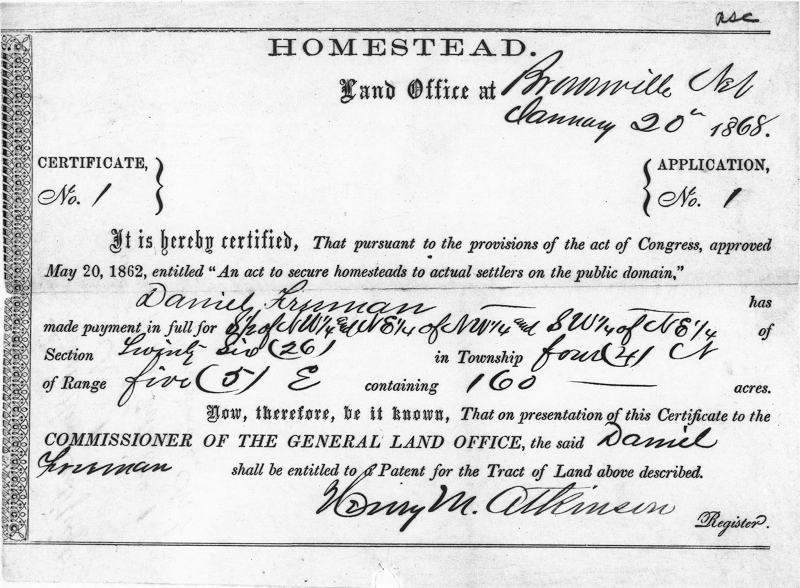Published: May 19, 2017
Brief History- excerpt from the National Park Service's "Homestead" webpage.
The Homestead Act of 1862 has been called one of the most important pieces of Legislation in the history of the United States. Signed into law in 1862 by Abraham Lincoln after the secession of southern states, this Act turned over vast amounts of the public domain to private citizens. 270 millions acres, or 10% of the area of the United States was claimed and settled under this act.
A homesteader had only to be the head of a household or at least 21 years of age to claim a 160 acre parcel of land. Settlers from all walks of life including newly arrived immigrants, farmers without land of their own from the East, single women and former slaves came to meet the challenge of "proving up" and keeping this "free land". Each homesteader had to live on the land, build a home, make improvements and farm for 5 years before they were eligible to "prove up". A total filing fee of $18 was the only money required, but sacrifice and hard work exacted a different price from the hopeful settlers. Daniel Freeman, a first Union Army scout was the first to take advantage of opportunities provided by the Homestead Act.

The Homestead Act remained in effect until it was repealed in 1976, with provisions for homesteading in Alaska until 1986. Alaska was one of the last places in the country where homesteading remained a viable option into the latter part of the 1900s. The Taylor Grazing Act of 1934 substantially decreased the amount of land available to homesteaders in the West. Because much of the prime land had been homesteaded decades earlier, successful Homestead claims dropped sharply after this time.
On March 16, 1936 Congress passed Public Law 480 of the 74th Congress created a new unit in the National Park System on the site of the Daniel Freeman homestead.
 On March 19, 1936, President Franklin D. Roosevelt signed the law and Homestead National Monument of America "as an appropriate monument to retain for posterity a proper memorial emblematical of the hardships and the pioneer life through which the early settlers passed in the settlement, cultivation and civilization of the Great West."
On March 19, 1936, President Franklin D. Roosevelt signed the law and Homestead National Monument of America "as an appropriate monument to retain for posterity a proper memorial emblematical of the hardships and the pioneer life through which the early settlers passed in the settlement, cultivation and civilization of the Great West."
16 U.S.C. 450u - Homestead National Monument of America; establishment
PDF
Details
Resources
Search govinfo for other documents related to the Homestead Act.
View the original Homestead Act document on ourdocuments.gov website, as well as read the document in text on the National Park Service's website.
Search the Library of Congress' website for articles and visual media about the Homestead Act.
Visit the National Park Service’s “Homestead - History and Culture” webpage, to find out more about the Homestead National Monument of America located in Southwest Nebraska, as well as read more about Freeman the first homesteader, and view other related documents such as a map of the homestead states.